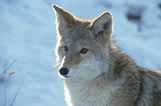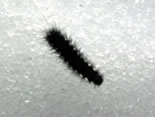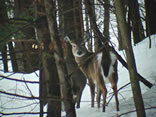
Nature Journal
| |
|
| Sunday, March 16, 2003 | |
|
Woke
up early this morning to the sound of the barred
owl. It was at a distance and moving away. It only hooted for
a short while and then was silent. |
|
| Saturday, March 15, 2003 | |
 The
coyotes were yipping and yapping over on the next ridge last night. The
coyotes were yipping and yapping over on the next ridge last night.It sounded like a small group, and they were moving pretty quickly along the ridge - which made me |
|
| Friday, March 14, 2003 | |
| As spring approaches, some of us are thinking about good places to go birding. Here's a website that has information about birding hotspots around the world. You'll find a list of U.S. hotspots by state here. | |
| Thursday, March 13, 2003 | |
 Here's
a photo of what might be the caterpillar of the Giant Leopard Moth
(Ecpantheria scribonia) - crawling along on the snow near a
neighbor's house. I took this photo yesterday when the temperature
was in the low 40's. Here's
a photo of what might be the caterpillar of the Giant Leopard Moth
(Ecpantheria scribonia) - crawling along on the snow near a
neighbor's house. I took this photo yesterday when the temperature
was in the low 40's. |
|
|
|
|
| Wednesday, March 12, 2003 | |
| Here's an interesting site for tracking the signs of spring - including the migration of monarch butterflies, hummingbirds, and other birds such as the red-winged blackbird, oriole, and bald eagle. It includes tracking maps for some of the species. | |
| Tuesday, March 11, 2003 | |
 Continue
to see the whitetail deer on
almost a daily basis. Until recently, had been seeing them in groups
of two or three. I believe that, in most cases, this was a doe with
her growing fawn or fawns. Continue
to see the whitetail deer on
almost a daily basis. Until recently, had been seeing them in groups
of two or three. I believe that, in most cases, this was a doe with
her growing fawn or fawns.Am now seeing groups of 5 or 6 deer |
|
same thing. Around this time, I start seeing larger groups of deer together. Sometimes there will be nine or more in one group. |
|
| Monday, March 10, 2003 | |
| The
eastern phoebe should be arriving
pretty soon - probably within the next week or 10 days. The phoebe
is one of the first migrant birds to return to New England. The males arrive before the females and begin singing their spring song. With the leaves off the trees, this is a good time to observe them and learn where their territories are. |
|
| Top of page |
|
|
| Birds | Butterflies | Mammals |
| Garden Shop |
New England:
Connecticut, Maine, Massachusetts, New Hampshire, Rhode Island, Vermont